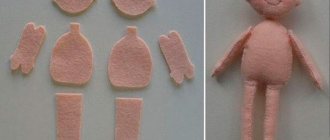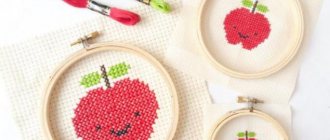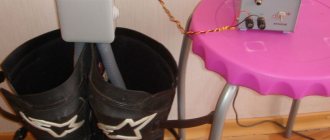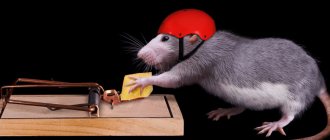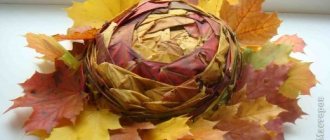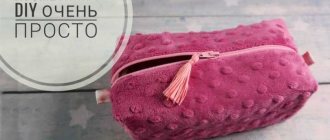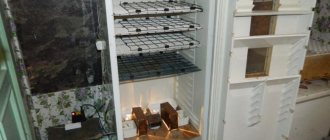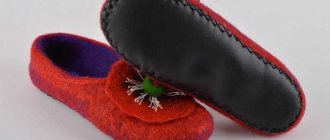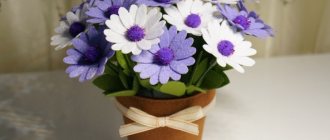- April 11, 2019
- Needlework
- Svetlana Funtova
A felt hat is a great addition to any look and style, from strict classic to daring street. Despite the wide range presented in stores, you can make this fashion accessory yourself at home. In addition, this skill will be useful when sewing a felt hat with your own hands, for example, for a child’s holiday.
Material selection
Felt is loved by needlewomen for its properties. It is pliable, like paper, sticks well, bends well, and is pleasant to the touch. But not every variety is suitable for making hats.
There are the following types of felt:
- With acrylic. Hard material should not be used to make products that will be subject to mechanical stress, they may simply burst. It is also worth noting that acrylic material cannot be used to make a felt hat with your own hands; it is better to leave it for children's creativity.
- With polyester. Durable, soft material, holds its shape well, used for making soft toys.
- Made from wool. Eco-friendly, safe, dense soft material. Craftswomen don’t really like it because of the limited color range and high cost. May be deformed after washing, not wear-resistant.
- Made from half-wool. A compromise option. Composed of synthetics and natural fibers in a ratio of 50 to 50. Plastic and soft material. Suitable for sewing garments.
- Made from viscose. This type of felt holds its shape perfectly, is soft, flexible, and durable. Able to pass air and absorb moisture. Serves for decoration. The disadvantage is that it wrinkles.
For the bath
Felt is the most perfect representative among all felt materials. It is made from the wool of rabbits, merino or mountain goats. Its use is ideal for bath hats, since these headdresses are quite voluminous, soft and delicate to the touch.
Tribley
Note! Now in the store you can buy children's hats for younger and older children. Felt hats are also used to decorate a variety of toys, dolls and snowmen.
What will you need for work?
For beginners, making this item of clothing may seem quite difficult, but with experience everything will become much easier and faster. Moreover, if you use blanks to sew a felt hat with your own hands, rather than felting the material by hand.
To work you will need patience and some components:
- wooden mold for making hats (sold in craft stores);
- a piece of polyethylene;
- felt blank;
- iron or steamer;
- buttons;
- felt hardener and brush;
- wire;
- twine;
- scissors, needle, thread;
- rep and satin ribbon.
We’ll look at how to make a felt hat and how to care for the product later in the article.
Lesson number 2. Everyone's favorite cylinder
It is quite possible that you will need to make a cylinder hat. This may be required for school work, to spend a weekend or to attend some fashionable and successful corporate event.
Making a cylinder is actually not that difficult if you follow the step-by-step “recipes”.
A wonderful cylinder can be made from ordinary cardboard. To do this you will need 2 sheets of colored cardboard. They must be proportionate to the product.
You also need to stock up on decorative ribbon to make a bow. You can also use a flower, such as papier-mâché.
You will also need scissors and a pencil, as well as a fairly large compass, an eraser, and, of course, glue. The glue must be suitable for all components of the hat.
- To begin with, you can look at photos or other pictures of real cylinders.
- Using a compass you need to draw a circle on a sheet of cardboard. He will be the main one. Diameter – Suitable for the required hat. You need to draw another circle from the center - it should be larger.
- The first sheet needs to be cut along the drawn circle.
- Next, up to the outline of the main circle, you should make strips with scissors, like a fringe.
- The strips need to be folded. This will be the first preparation.
- The second leaf needs to be cut along a large contour.
- Then a circle of small diameter should be made from it.
- Before the start of the main circle (inside), you need to cut strips in the form of a fringe, as in the first case.
- Then the stripes should be folded. This will be the second blank.
- You need to make a strip (cut) out of cardboard; its width should be equal to the height of the cylinder we are making. The length should be a little longer than the main circumference.
- Then we wrap the strip into a cylinder. There must be an overlap for gluing. Then we glue the cylinder so that its circumference is equal to the main circle.
- Then we coat the fringe with glue in the second workpiece.
- The fringe is glued to the inside of the cylindrical part.
- You should coat the first piece with glue, or rather its fringe.
- You need to glue the fringe to the inside of the cylindrical part on the other side.
This will do the bulk of the work. Now you can safely design the resulting cylinder. You can cover it with decorations, you can make a ribbon with a bow, you can refresh it with decorative flowers.
Uncover
To make a simple headdress we need material and a pattern. Details can first be drawn on paper and then transferred to felt.
To create a pattern, measurements are taken from the head. The diameter will be equal to the circumference divided by 3.14. Draw out the details on paper:
- Round bottom - 1 pc.
- Crown elements 10 - 15 cm high - 2 pcs.
- Parts of the fields (the size is chosen at the discretion of the master). Most often, the radius is a maximum of 30 cm on the outer side and 20 cm on the inner circle - 2 pcs.
The parts are laid out on a sheet of felt, outlined, and cut out using scissors or a roller/stationery knife. When cutting, you need to pull back the edges to make them easier to cut.
Witch hat for cocktails
This small, elegant headdress is part of the image of an elegant witch who has not yet completely surrendered herself to the forces of darkness. Typically, such an accessory is attached with pins. You can make a cocktail hat from fabric and cardboard (it is needed for the frame).
Usually the crown is decorated with large beads. Where the brim and crown meet, a satin ribbon is often attached. A cocktail headdress greatly emphasizes the elegance of the wearer.
No Halloween party is complete without a charming witch. And the hat is the main attribute of every witch. Anyone can make such a hat on their own.
Not only is it very simple, but the pointed headdress looks very attractive. A witch who wears such a hat will catch men's gaze all evening and will be remembered by everyone as elegant and irresistible.
Tips for preparing the mold and workpiece
The blank for making a hat is placed on a flat horizontal surface. It is better to cover it with plastic wrap and secure it with adhesive tape or an elastic band so that it does not move. Of course, you don’t have to use polyethylene, but this will make it easier to remove the product.
The final result will depend on the appearance of the form; this is important to consider when purchasing it.
Another recommendation relates to the workplace. Since felt hardener has a pungent odor, the room should be well ventilated to eliminate possible headaches and dizziness from intoxication.
It is better to purchase a felt blank for sewing a felt hat with your own hands at a craft store. As a rule, it is a cap. It must be turned inside out and coated with hardener using a brush. The product should saturate the material well, but not seep out from the front side. In the absence of blanks, wool felt can be purchased at any specialized store.
Hats for strong and fashionable men
A man who wears a hat immediately becomes more attractive in the eyes of beholders, as this adds a special brutality to him.
You might be interested in this Step-by-step instructions for sewing a tulle petticoat yourself
Decoration
Representatives of the stronger half of humanity wear the following styles of felt hats:
- Tribley. This variety is distinguished by the presence of a longitudinal dent in the center and small fields that are slightly turned up.
- Pork pie is a classic version, the features of which are the presence of a cylindrical crown, decorated with a ribbon, and a horizontal top.
- Fedora. This type of hat is the most common among men. It is distinguished by the presence of dents on the front and sides. It is made of soft and pliable felt and is best suited for casual style.
- The Homburg is a hat that goes perfectly with a classic suit. It has a dent in the center, rolled edges and a fixed shape due to the rigidity of the material.
With a bow
Due to such a variety of accessories, men have scope to realize their fantasies. A felt hat can be ideally combined with both trousers and jeans, both T-shirts and shirts, thereby adding uniqueness and aristocracy to each look.
Fixing, processing and steaming the workpiece
In the next step, the cap is turned out and put on the mold with the treated side. The blank is turned over, and the edges of the felt are attached to its bottom using buttons. It’s better to start from the top and bottom, then fix it on the right and left, gradually reducing the remaining gaps. The product is left for 30 minutes, during which time it should dry.
Then a towel or a double layer of gauze is placed over the workpiece and ironing begins. To do this, the device sets the wool processing mode and activates the steaming function. It is important that the fabric over the hat does not bunch up. The entire surface from top to bottom is evenly steamed with an iron. As you iron, the felt should harden and take the desired shape. As a rule, 5 - 10 seconds of steam exposure is enough for one area.
History of the witch image
How did pointed hats come about? It is no secret that the image of a witch is closely connected with religion.
People believed that witches killed children, were familiar with the Prince of Darkness, and considered the purpose of their lives to harm people. Then they flocked to sabbaths, boasted about their tricks and had unbridled fun.
Pointed witch hats were their attribute only in the West. Baba Yaga, although she was a witch, preferred scarves, and Margarita from Bulgakov’s work did not wear clothes at all.
At first, this headdress did not have a negative connotation. The pointed hat comes from Egypt. In Europe, these hats were popular among the male part of the population.
In the Middle Ages, witches appeared completely naked. Soon the witches began to hide, and they were indistinguishable from a simple city girl. In the 17th century, witches' hats appeared in literature and art. The sharp end is believed to hint at a connection with the forces of darkness.
Soon the image gained popularity and after a couple of hundred years this type of headdress became the main attribute of a real witch. Such an image is usually not considered complete without a broom and a faithful dark companion (a bat or a black dog).
Using twine
The twine is wound around the crown in the place where the brim of the future hat should begin. For this purpose, you can use a special elastic band, which can also be purchased in the store. This manipulation allows you to create a fold on the cap between the crown and the brim. In the future, the twine can be removed, since it will not be useful after the product is formed.
It's worth noting that not all types of hats have brims. For example, a “tablet” looks like just a crown. If you plan to make just such a felt hat with your own hands, then you need to skip this stage with twine. Alternatively, you can attach a series of buttons end-to-end around the circumference of the crown, but they often leave puncture marks and dents in the fabric.
Knitted beret
First you need to choose the right pattern. The stages of the work are as follows:
- Secure the side parts.
- Iron along the seam.
- Attach the bottom to the side.
- Iron the seams.
- At the last stage, sew on the band.
If the product is made of thin knitwear, then you can sew a lining to it. Cotton is suitable for lining. You need to cut out the inside in the same way as the beret itself. The lining is sewn on after all the other main parts have been sewn.
Inserting wire, sewing tape
To shape the brim, you can use special hat wire. She shouldn't be fat. The required length of wire is measured along the perimeter of the fields and cut with wire cutters. The wire is carefully sewn along the edge using a loop stitch. The threads should match the color of the felt as closely as possible. The fields will become stiffer and stronger. If they are planned to be soft, this step can be skipped.
Sewing on the ribbon is mandatory if the fields are reinforced with wire; in other cases this is purely a decorative finish. A piece of grosgrain or satin ribbon is cut and sewn as close to the edge of the brim as possible. Its front side should lie on the surface of the hat, and it can be processed manually with small stitches or on a sewing machine. Then the tape is turned back to the bottom and sewn again.
How to decorate a felt hat with your own hands
Surely everyone has at least once seen a grosgrain ribbon inside a hat, sewn along the edge of the crown. To add such a frame to your product, you need to cut a piece of the required length and sew the ends together. The finished ring is inserted into the hat and sewn to the edge of the crown from the inside. It is important to note that the tape must pass strictly where the fields diverge. This trick will allow the hat to keep its shape. To prevent the stitches from being visible, the tape must be turned away.
Decorating a felt hat with your own hands is the most interesting and creative stage in the process of making a headdress. The product will look more neat if all the details are sewn on by hand with hidden stitches. Alternatively, you can use hot glue or a special adhesive base for fabric.
You can do the following:
- The simplest and most classic design is considered to be a ribbon wrapped around the crown. The ends can be disguised with a flower or a bow.
- Felt decorations look good. Here you can use material in the same color scheme or the opposite, contrasting one.
- Another option is a product decorated in a vintage style. A ribbon is sewn around the crown and a thin feather is tucked behind it. You can add leather elements for decoration.
Sewing various models
For beginners, it is better to opt for simple styles, otherwise the hat may not work out. The most important thing here is to choose the right pattern.
Sewing a women's hat
It will require knitted fabric 1.5 meters wide and 0.3 meters long. First you need to find a pattern and print it. The size of the hat is equal to the circumference of the head (52 cm) - 4 cm = 48 cm. 48/2=24 – the width of the hat according to the pattern. You need to leave a centimeter on each side for the seams.
Cutting out the hat
To work you will need:
- Scissors.
- Pins.
- Threads to match.
- Knitting machine needle.
- A regular needle.
- Ruler.
- Centimeter.
- Soap.
We sew a hat according to the following pattern:
- Place the fabric wrong side down. The width of the main part is 25cm.
- Leave 1cm from the top cut for the seam.
- Divide the cut into 4 parts (24/4=6cm).
- Find the middle of each of the slices 6/2 = 3 cm.
- Connect the midpoints of the segments with points located at 6cm. Mark them with arcuate lines.
- Cut out the resulting model.
Sewing a hat
- Grind down the cap wedges along the top edge.
- Do the same with the lining of the hat.
- Sew down the middle seam on the main piece and on the lining. It is better to sweep the seams by hand to avoid the seams moving.
- Sew both hats (main and lining) together. Turn the main item inside out, place the lining in the hat so that they are right side inward, and align the seams and pin together to prevent the fabric from shifting.
- Sew down the parts using a zigzag stitch.
- Remove the pins and turn the product right side out.
- Open a small seam on the lining and turn the hat inside out through the resulting hole.
- Sew the ripped hole with a blind stitch.
Useful tips
In order to correctly and without any problems make a felt hat with your own hands for a child’s party or an interesting headdress for the street, you should follow these recommendations:
- When preparing the mold, polyethylene film is applied in such a way that no gaps are formed.
- When using the blank, the product will be thin and smooth. A hat made from felted wool is usually denser and rougher.
- Often, a wooden form is expensive; it can easily be replaced with a more affordable plastic or polystyrene base.
- As a last resort, the mold can be made from scrap materials, for example, from an inverted round bowl. However, it must be the same size as the head.
Advantages of the material, how to care for the product
Compared to hats made from synthetic or cotton fabric, felt has many advantages:
- retains its shape for a long time;
- has a pleasant texture;
- affordable price of the product;
- weather protection.
In order for a hand-made hat made of leather and felt to retain its original appearance longer, you must adhere to the following recommendations:
- The product cannot be washed, it is better to take it to dry cleaning;
- To prevent the headdress from becoming deformed, do not hang it on a hook;
- clean the hat with a soft brush, wipe the leather inserts with a damp cloth;
- store the product in a box with the brim down; you can put a crumpled piece of newspaper into the crown;
- if the hat gets wet, place it on a flat horizontal surface and dry it at room temperature.
It's not always easy to find a hat of the right shape and color. Of course, with the design everything is much simpler; you can also decorate the finished product. However, some people find it difficult to choose a hat due to personality, style, and other reasons. In such cases, it is recommended to try to make it yourself. Perhaps this will not be the last headdress made with your own hands.
LiveInternetLiveInternet
—Categories
- Do-it-yourself (knitting, embroidery, crafts (2170)
- Knitting magazines (163)
- Dresses, skirts, sundresses (149)
- Jewelry, decorations. (148)
- Blouses, tops, T-shirts (105)
- Home decor (95)
- Mabel (89)
- Jackets, cardigans, blazers, ponchos (87)
- For your favorite feet (84)
- Pullovers, jumpers, sweaters (78)
- Knitted sets (74)
- Scarves, shrugs, stoles (73)
- Patterns, schemes (70)
- Knitting lessons (57)
- Children's (46)
- Knitted toys (40)
- Leg warmers, socks, stockings (38)
- Capes, stoles, shawls, boleros (34)
- Hats (32)
- Tunics (31)
- Works by Liru needlewomen (when your hands are OWN!) (29)
- Embroidery (26)
- Men's (26)
- Swimwear (25)
- Rare techniques (19)
- Vests (15)
- Creative (11)
- Coats, jackets (8)
- Felted pears (7)
- Knitting terminology, dictionaries, explanations of patterns (7)
- Mittens, gloves, mitts (4)
- For animals) (4)
- Machine knitting (4)
- Pants, shorts, capris, breeches (2)
- Goodies (1257)
- Desserts (136)
- Snacks (111)
- Salads (90)
- Baking (87)
- Meat (70)
- Blanks (67)
- Cakes, pastries, cookies (61)
- Vegetable dishes (47)
- About products (42)
- Drinks (42)
- Sauces, dressings (27)
- Seafood and fish (24)
- Casseroles (23)
- Table setting (19)
- Bread (18)
- Pasta (pasta) (15)
- National cuisine (14)
- Soups (14)
- Homemade (anti-shop) (14)
- Grilled (11)
- Main courses made from dough (10)
- Cookery books (magazines) (7)
- Bread machine recipes (7)
- From the chef (6)
- Videos - recipes (4)
- Lenten dishes (2)
- Flea market (942)
- Animation (211)
- Comments with codes (147)
- Flash (98)
- Watch (33)
- Frames (20)
- Smilies - comments (19)
- Dividers (16)
- Backgrounds (11)
- Author's animation (Nikash) (7)
- Sewing (581)
- Alterations (127)
- Dresses, skirts, sundresses (90)
- Decor (84)
- Toys (33)
- Curtains (27)
- Children's (23)
- Tops, T-shirts, blouses (12)
- Magazines (10)
- Underwear (7)
- Pants, shorts, capris, breeches (6)
- Hats (4)
- Men's (4)
- Hand made. (481)
- hand made for the holidays (97)
- Decor (82)
- Panels, souvenirs, crafts (78)
- Flowers (paper, leather, fabric) (29)
- Packaging (27)
- Decoupage (22)
- Newspaper weaving (21)
- Postcards (16)
- Magazines on crafts (weaving, souvenirs) (11)
- Shabby - chic (9)
- Soap making (9)
- Polymer clay, salt dough and all that) (6)
- Modular origami (6)
- Monigami (4)
- Candy bouquets (1)
- Intarsia (cutting from wood of different species) (1)
- Bags, handbags, bags) (271)
- AZBUKA Li.ru (228)
- Diets (215)
- Photoshop and everything connected with it (204)
- Lessons. (54)
- Brushes (34)
- Animation (lessons) (17)
- Photoshop video tutorials (10)
- My lessons (3)
- My author's translation of lessons (2)
- Beauty! (174)
- Queen's body! (75)
- Hair (32)
- Handles (5)
- Legs (1)
- Interior (165)
- Blogging (147)
- Earning money online, monetization, SEO (41)
- Affiliates (35)
- Video tutorials (1)
- Photos (141)
- Food style and food stylists (8)
- Interesting things (124)
- Tests (41)
- Computer programs, widgets, etc. (117)
- Artists (104)
- Training (101)
- Illustrations and illustrators (98)
- Postcards (20)
- Blah blah blah. (96)
- Fashion (96)
- Required sites (90)
- Clipart (80)
- Tips, tricks, techniques (69)
- Homo Sapiens (64)
- Psycho. (12)
- Fathers and sons (10)
- Design (63)
- Stardust (horoscope) (61)
- Galloping across Europe and beyond (61)
- Garden, vegetable garden, landscape design (53)
- Carving and decoration of dishes (53)
- That's funny! (52)
- Decorations (flowers) (48)
- Photographers (42)
- Great and mighty! (internet) (41)
- Entertainment (32)
- Her Majesty advertisement (31)
- html (30)
- Autopasses and more (30)
- Knitting techniques (22)
- Innovation, technology (22)
- Art (18)
- Be healthy! (17)
- Traditional medicine (1)
- Sothink SWF Easy (14)
- Videos (14)
- Menagerie (13)
- Download. (12)
- Books (5)
- Music (10)
- Gold Rush (9)
- Lingvo (8)
- Fonts (2)
- For friends! (7)
- CorelDRAW and everything connected with it (7)
- CSS (7)
- Infographics (6)
- Kunstkamera (6)
- Drawing (MK, lessons) (5)
- Painting (1)
- Flash - lessons, theory and practice (4)
- Master's corner (2)
- Online games (2)
- WEB (2)
- Adobe illustrator (lessons, articles, tutorials) (1)
Popular articles Floating cup - money waterfall

